History of the Press Release

Gaining Value from Tactics New and Old
While many find the press release to be an antiquated and now inefficient method of delivering content, the truth is that the press release is far from dead.
There are many audiences online who still rely on press releases as key sources of information.
Be it tradition or its deep roots, they continue to be used, and by more than just public relations (PR) departments. Except nowadays, many different types of press releases serve many different purposes.
But if you’re interested in creating effective and relevant press releases for distribution, you’ll have to understand the history, its evolution in a growing content universe, and all of the options you have available to you.
Consider this a crash course in all things press release:
A Brief History of the Press Release
The press release originated during the year of 1906, after a train wreck in New Jersey took the lives of more than 50 people. At the time of the accident, the train was owned by the Pennsylvania railroad.
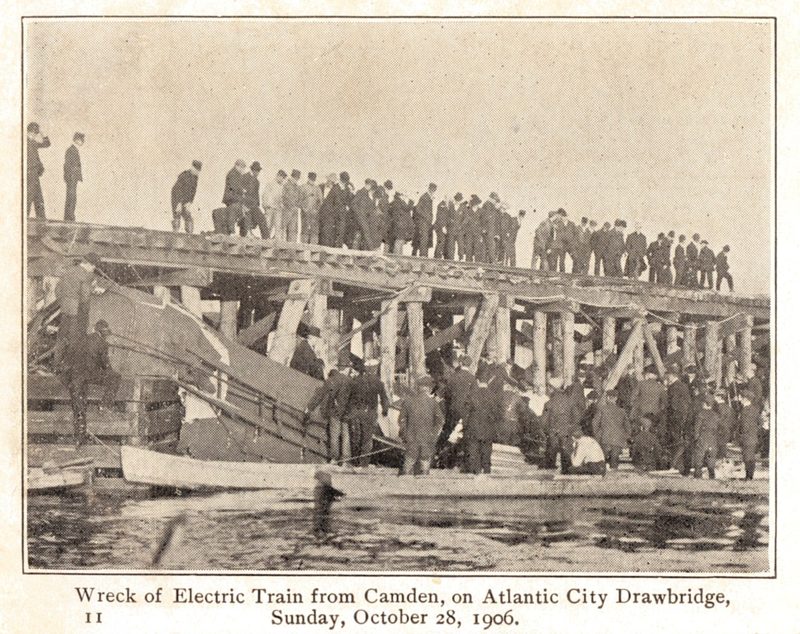
In response to the tragic accident, the rail company’s publicity expert, Ivy Lee, issued a press release detailing what happened. The release garnered such publicity that even The New York Times published it. And according to rumor, exactly as it was written.
The statement issued by Lee and published by newspapers is believed to be the first of its kind.
Lee followed up with a “Declaration of Principles” when accused of attempting to manipulate press releases, which has acted as the foundation for journalistic integrity ever since:
This is not a secret press bureau. All our work is done in the open. We aim to supply news. This is not an advertising agency; if you think any of our
matter ought properly to go to your business office, do not use it. Our matter is accurate. Further details on any subject treated will be supplied
promptly, and any editor will be assisted most cheerfully in verifying directly any statement of fact. Upon inquiry, full information will be given to any
editor concerning those on whose behalf an article is sent out. In brief, our plan is, frankly and openly, on behalf of business concerns and public
institutions, to supply to the press and public of the United States prompt and accurate information concerning subjects which it is of value and interest
to the public to know about. Corporations and public institutions give out much information in which the news point is lost to view. Nevertheless, it is
quite as important to the public to have this news as it is to the establishments themselves to give it currency. I send out only matter every detail of
which I am willing to assist any editor in verifying for himself. I am always at your service for the purpose of enabling you to obtain more complete
information concerning any of the subjects brought forward in my copy.
The movement—to publish news on behalf of a company, and to do so honestly—led to a barrage of other companies publishing press releases to announce company news.
Evolution of the Press Release in a Growing Content Universe
While we now have multiple ways of receiving information, and at lightening speed, many rely on press releases as their primary source of news.
Just take a look at the timeline:
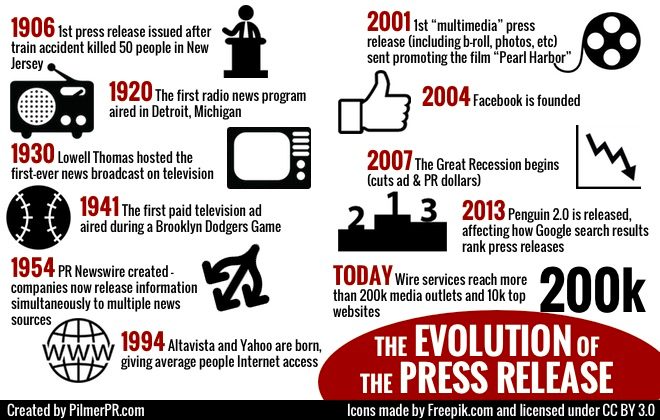
In fact, data published by the American Press Institute reveals that just under 50% of Americans get their news from online sources, and just over 30% get their news primarily from newswires.
That’s a rather large number, especially considering the massive impact Google Panda 4.0 had on press release sites and their devaluing of link building tactics used for SEO.
That’s one solid stat for the haters.
It’s evident that despite the changing mode of publication and setbacks from Google, online press releases continue to be a sought-after form of sourcing interesting and often new information.
Now, it becomes more about what they can still do for your business and what you can do to navigate the process.
What Are the Benefits of Press Releases?
The short answer is that they provide targeted consumers and interested parties with relevant and worthwhile information about your business.
But there are many additional benefits to using press releases:
- Increased traffic from strategic keyword placement
- Pagerank improvements from implied links
- Distribution and referral traffic across news outlets
- Fresh content for frequent indexing and authority potential
- Widespread exposure from social sharing activities
- Sourceable content for journalists and interested parties
Not convinced of their continued ability to make an impact online?
Take a look at how a Nintendo press release drove 500,000 views in a single day:
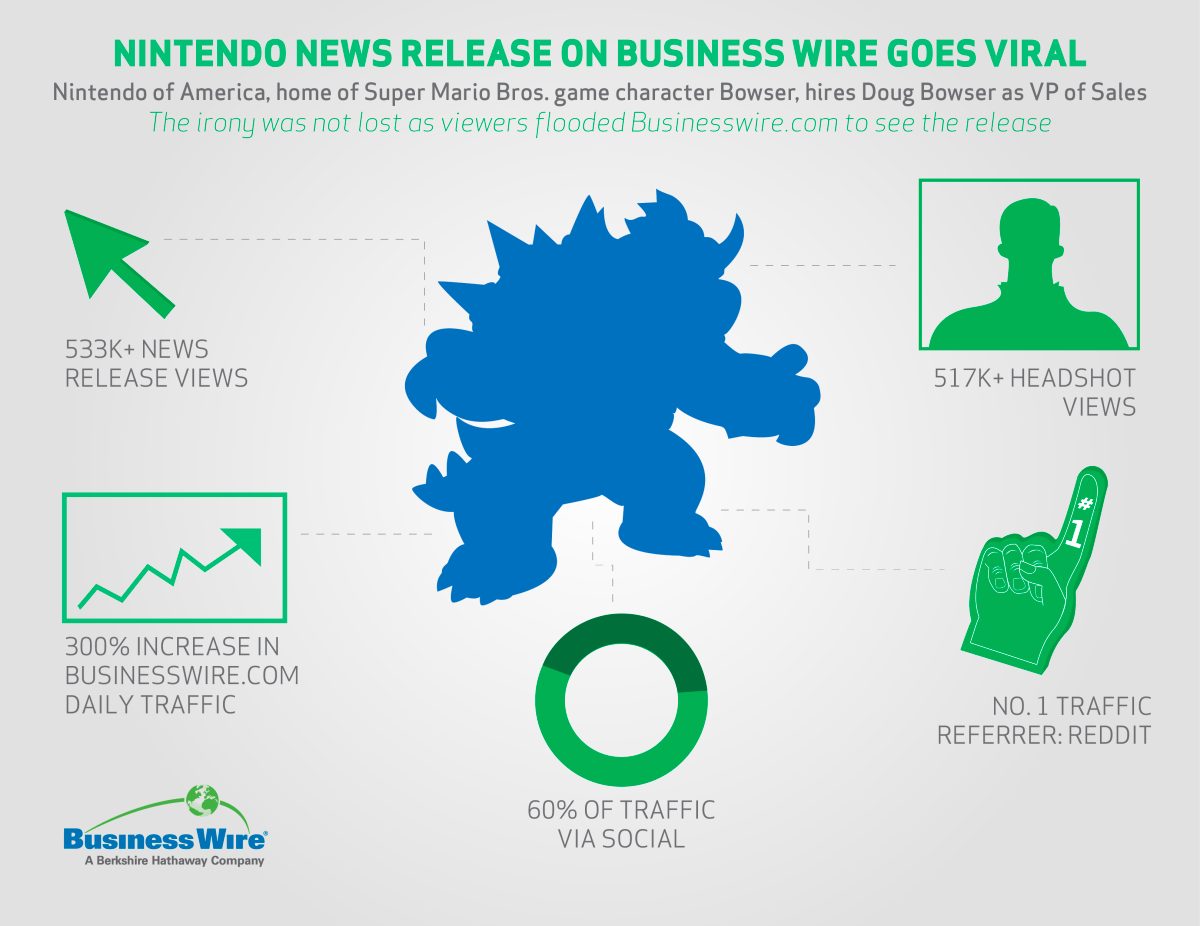
With 60% of press release traffic originating from social media, Nintendo proves that when done properly, active sharing can make a huge impact on awareness around a topic, story or update.
And if that wasn’t enough, the release also drove a 300% increase in daily traffic to BusinessWire, where it was originally published.
Through coverage on mainstream media outlets such as The Washington Post and CNBC and its combined force of social media virality, it has become one of the most effective press releases online to date.
If the press releases is dead, how did this happen?
The New Elements of a Strong Press Release
The PR example above illustrates just how effective a press release has the potential to be.
But even if you recognize the value of a press release, you’re probably wondering:
How do I create a press release that drives traffic and increases brand recognition?
The answer: By employing best practices per Google’s demand for high-quality content.
Regardless of type, the essential elements of a strong press release should work together to serve the purpose of providing the most valuable experience a reader can have with your content.
Let’s break down Nintendo’s press release to discover why it won audiences, social and search over:
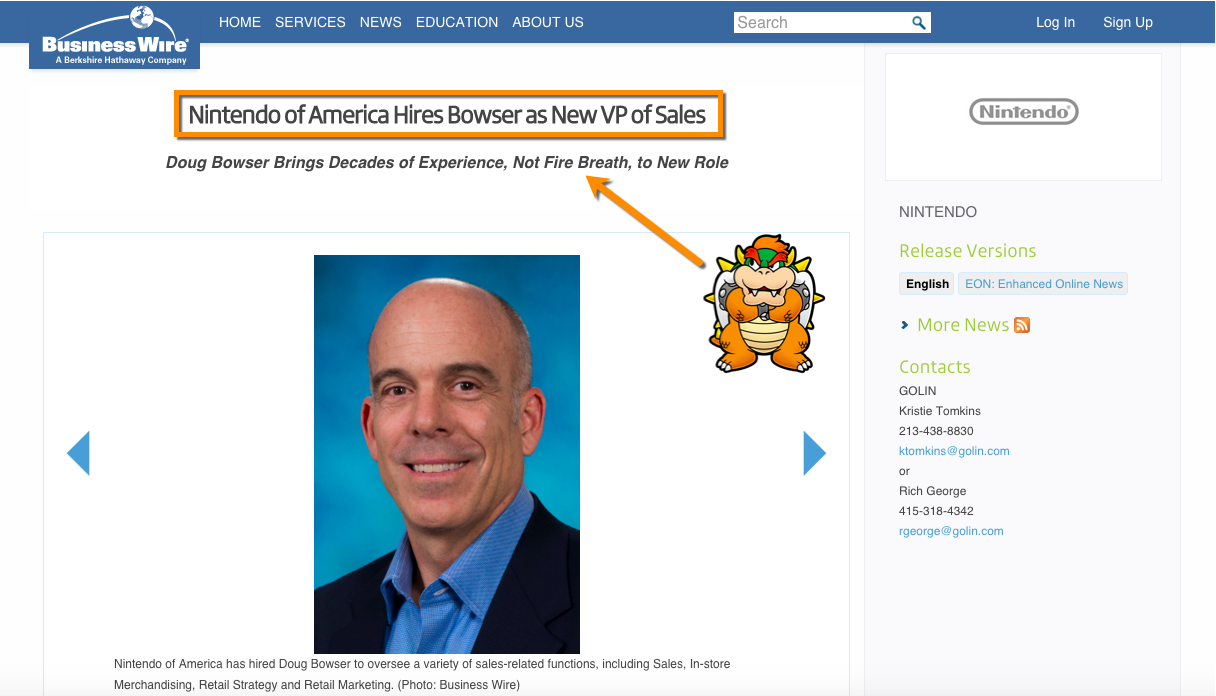
It’s amazing what a strong headline and some humor can do.
Nintendo played on the name of their new VP of Sales, joking about his relation to their popular character Bowser. It not only rendered it incredibly relevant to video game fans across the globe, but also journalists looking for content with substance.
And their boilerplate didn’t pull any punches:
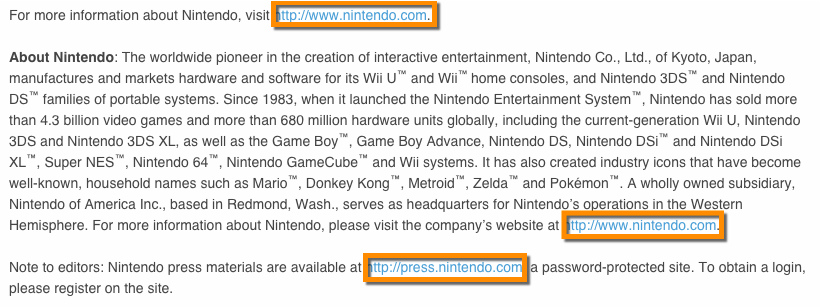
Notice all of the natural links and lack of anchor text.
Using this example as a foundation, a successful press release should:
- Prioritize a brand’s story, not the brand
- Have a thoughtful and interesting headline under 120 characters
- Contain the important information audiences will be seeking
- Use subheadings to provide context for the reader
- Include implied links or natural links for brand names and websites
- Be formatted with proper spacing and bullet points for readability
Other best practices include always including a boilerplate paragraph (example below), keeping your press release as objective and newsworthy as possible, including a date, and making sure contact information for media inquiries is readily available.
If the recipient only reads the headline and the first paragraph, they should get a pretty good idea of what the story is about.
When it comes time to actually publishing, you can choose to opt for publishing sites like PRNewswire or ReleaseWire, just remember, these agencies lost up to 85% of their visibility only days after Google’s update.
But that doesn’t mean targeted audiences aren’t still looking for your press release content, or even that those distribution channels are completely ineffective. After determining what type of press release will bring your business the most value, think long and hard about your options.
More on that, below.
Three Types of Press Releases
There is no longer just one press release format.
Online platforms have made it possible for PR practitioners and content marketers to reach their target audiences in a variety of ways. Yet the sheer abundance of content means that knowing your target audience has never been so necessary.
From hosting press releases on websites, through blog posts and social media, to within video footage, infographics and other forms of online content — the opportunities are endless.
A content marketer and PR manager should be aware of and utilize the following:
1. Traditional Press Releases
The closest thing we have today to Ivy Lee’s announcement about the Pennsylvania rail crash; these press releases are announcement oriented.
While often associated with some sort of emergency (like a product recall), they typically announce new products, upcoming events, and major company changes.
These types of press releases can be beneficial for a myriad of company types as the purpose is to provide information to consumers, tell stakeholders what they need to know, and publish facts.
Format and structure do not matter nearly as much as the objective nature, which is to read like a piece of news that complements the brand’s story.
If you’re not sure where to start or whether you’re in compliance with Google, they host a ton of templates you can use to build that story out with ease and peace of mind.
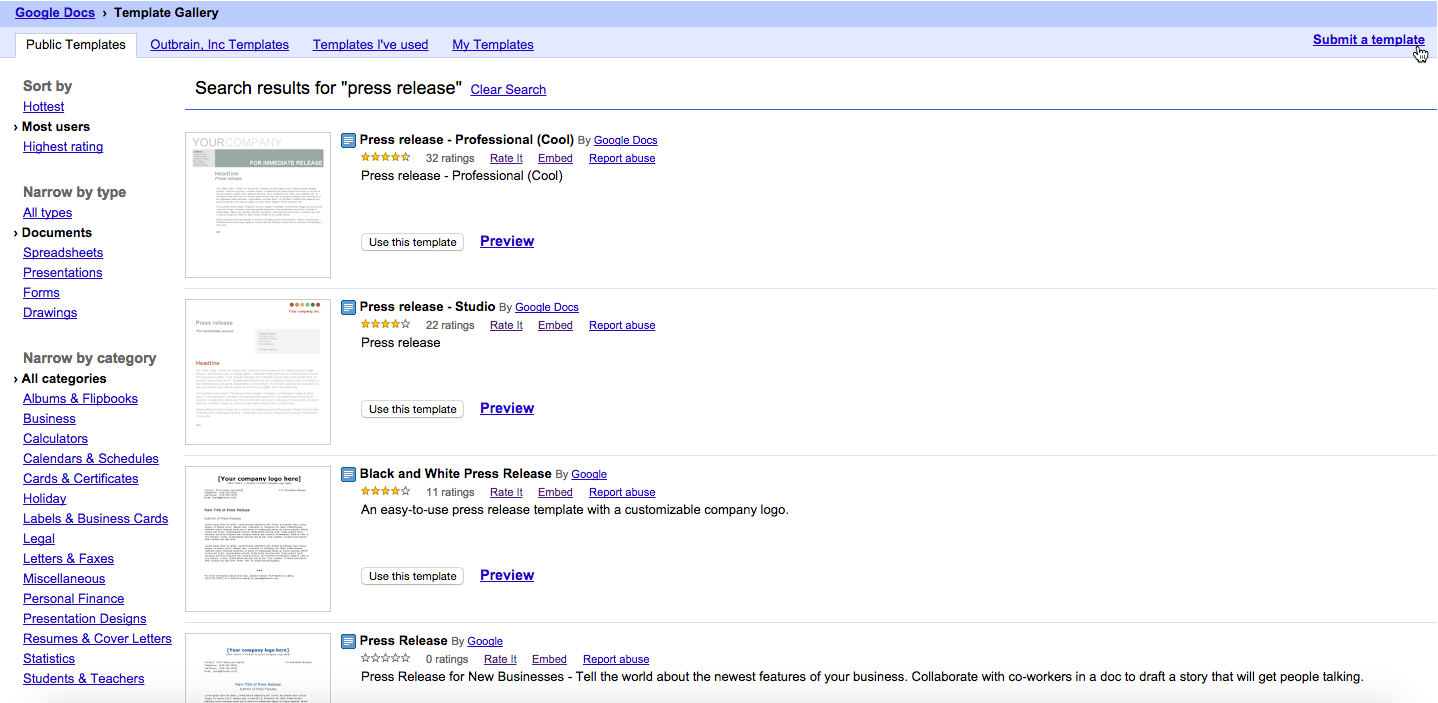
It’s also worth remembering that if you’re writing for online, your release content has the potential to reach millions of people across the globe. Consider how your words could be interpreted – or misinterpreted – by non-native speakers.
2. SEO-Targeted Releases
A press release geared towards search engine optimization is similar to a traditional press release, except that its purpose is to attract customers by driving traffic organically.
Companies once used SEO-targeted releases when they noticed their search engine rankings were faring poorly and needed a boost.
As you can tell, now things are a little different.
But that doesn’t mean SEO targeted releases have been rendered useless. Brand’s should still be creating press releases that are as newsworthy as possible and including keywords with strong value to their mission.
Keywords should be placed naturally within the headers and boilerplates of a press release though they should not contain any anchor text.
Google’s example for what will not fly anymore:
There are many wedding rings on the market. If you want to have a wedding, you will have to pick the best ring. You will also need to buy flowers and a wedding dress.
3. Social Media Press Releases
This will become the bread and butter of your press release initiatives.
Because it’s the perfect hybrid between a standard social media post and a newsworthy blog post which can also help your organic SEO without link schemes.
Bringing it back to Nintendo, see how they’ve created a social sharing opportunity in a way that is useful to readers and drives engagement:
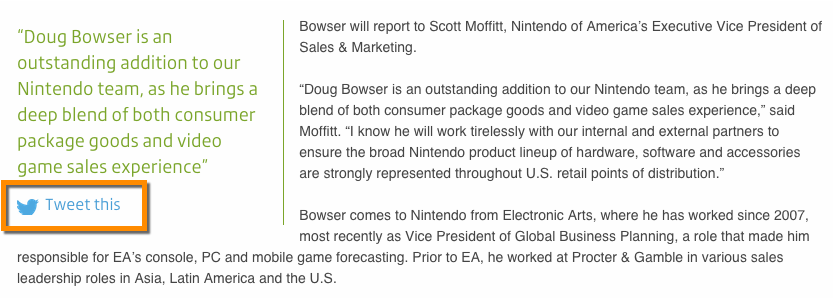
Make sure to include all of the relevant information pertinent to your release (i.e. what you want to share with your larger target audience), as well as everything a user on social needs to engage with the release and share it across active platforms.
Furthermore, remember that a social media press release isn’t designed just to target journalists, whom you are hoping will re-publish your news; instead, you are targeting journalists and bloggers and consumers.
PR Underground suggests some of the following tips:
- Remember your target market – As discussed above, make sure the release provides information that is valuable to the wider demographic of users you can find on social media.
- Put keywords in your headline – You still want to rank for specific keywords or phrases that are relevant to your release, especially if things pick up on social media and more people are searching for your content.
- Trending topics – Using tools like Google Trends & Google Insights (even Facebook and Twitter trends), try to incorporate what conversations are happening online into your release. Nothing says pageviews like jumping onto a hot topic with valuable information about your brand.
- Media rich – Videos are great for engagement, especially on social media. Make sure your social media press release is optimized with the multimedia people love to share and engage with.
- Strong meta description – Nothing grabs the attention of a user more than a tightened meta description and title. When users go to share on platforms like Facebook and LinkedIn, you’ll have even set them up for success by reinforcing what messages you really want people to see.
- Make it readable – Free of spelling errors, large chunks of text and font that is too big or too small. Keep readers engaged with a well-formatted piece of content, equipped with headers, sub headers, bulleted lists and short paragraphs.
- Use plain language – Don’t limit your audience by using technical language or industry jargon. Use words and common phrases that everyone can digest and understand.
- Be succinct and repeat – In today’s PR landscape content is often visible for the briefest of times, so deliver concise communication on a frequent basis.
The Tangible Distribution Strategies
The tides have turned, and we’re all being held more accountable for the quality of our content.
Our tried-and-true methods for gaining exposure no longer hold the same power, and we’re now tasked with taking control of our content and how it gets distributed.
Thankfully, Google has done a great job at setting good content up for success:
The best way to get other sites to create high-quality, relevant links to yours is to create unique, relevant content that can naturally gain popularity in the Internet community. Creating good content pays off: Links are usually editorial votes given by choice, and the more useful content you have, the greater the chances someone else will find that content valuable to their readers and link to it.
All we have to do is use the tools available to us.
In addition to utilizing newswires (who are also making content improvements to abide by Google guidelines), social media is an incredibly effective channel for creating the kind of traction that will truly launch your press release into the stratosphere as witnessed above.
Other strategies might then include amplifying earned media from buzz generated on social in the form of a third party article, like the one CNBC wrote about Nintendo’s press release in order to get your content discovered:
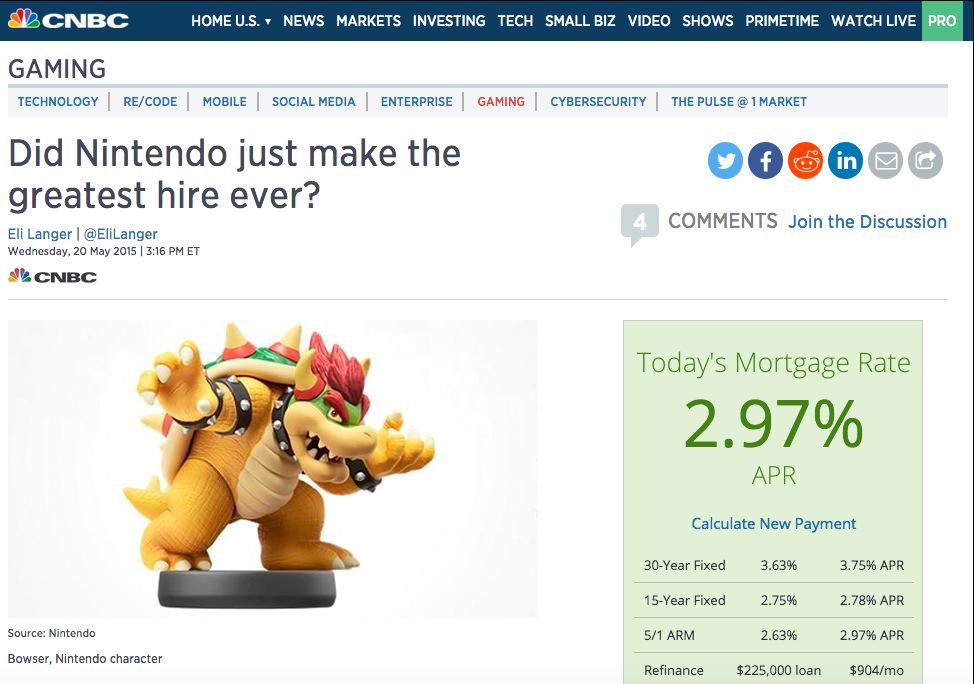
And if you really want to make an impact, even with a small budget, throwing PPC and retargeting efforts into the mix.
Whatever path you choose, remember you have options.
Tap into the Power of the Press Release
Dated practice or not, the press release is still a valuable tool for helping increase recognition across news outlets, search, and social media.
When tapped into correctly, this relic of public relations provides meaningful parties with need-to-know information about your brand, business or company while contributing to overall site traffic, engagement and even leads.
I hope you enjoyed reflecting on the origin of the press release and can take a few of the tips and learnings from this article to keep up with its consistent evolution in a new age of online content.
